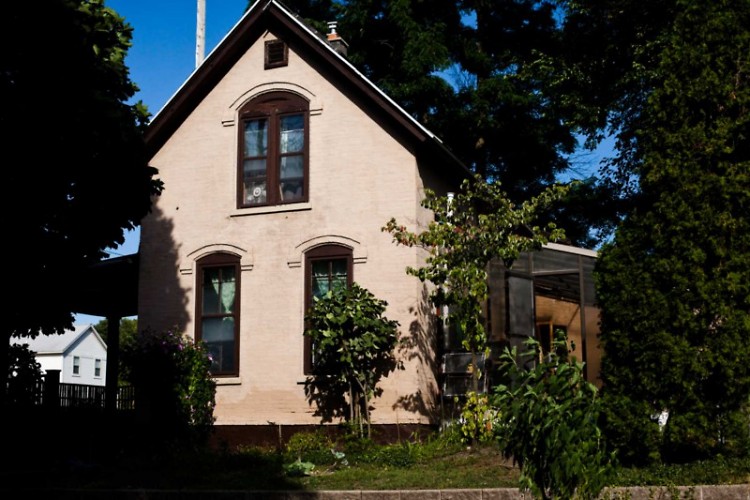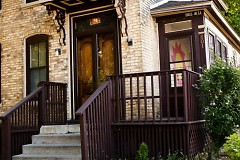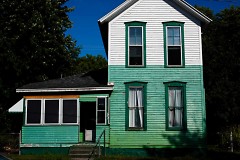In the late '70s, a woman by the name of Marian Clements purchased an 1870's era home at the corner of Pleasant and Cass, in what is now the SECA neighborhood, for $350. She called it Well House. Clements had experienced severe depression, and had found that she was not suited to "mainstream" culture. After finding support with a Quaker Community, she took the bold and courageous step to open a hospitality house for others who may be poor, feeling isolated or otherwise not finding a place to land and be safe. She later acquired two more houses on the same block and a vacant lot. Well House would go on to provide refuge for thousands of people over the next 36 years.
I accidentally found myself part-time director of Well House in December of 2012. After Clements's untimely death of breast cancer in the mid-nineties, Judi Buchman and other activist friends of Clements' kept Well House running, and continued her vision of housing some of our most vulnerable neighbors and living "gently" on the earth. Buchman retired a couple of years ago, and the organization struggled to keep its doors open. As a former Well House Board member, a friend of Buchman's and a former social worker who spent a great deal of time researching evidence-based approaches to solving homelessness, I decided to try to save the organization.
Well House is now permanent housing. That is, people sign a month to month lease, and can stay as long as they like if they are meeting the requirements of the lease. They have a private room with a lock on the door, and share several common spaces including a greenhouse and our extensive gardens. We have a small but mighty staff that work to build community among our tenants and connect them with whatever it is they feel they need, including employment, counseling, volunteer opportunities, health care and transportation.
We are hyper-targeted in our efforts. We use the "Vulnerability Index" to determine which applicant is most likely to not access any other housing in the community, and we only accept people that are residing at Guiding Light Mission, Open Door, Mel Trotter Ministries or who are "unsheltered," which means they are living in a car, abandoned building, under a bridge or something similar.
We have received over 200 applications, about half of those meet our eligibility criteria.
We cannot end homelessness unless we are strategic. We house the most vulnerable and least likely to be housed by anyone else first.
Since January of 2013, we have moved 22 of our most vulnerable citizens off of the street and out of shelters. We have been operating three houses thus far, but have received funding for four more through the W.K. Kellogg Foundation and the Grand Rapids Community Foundation. Two are currently being rehabilitated.
What does it mean to our residents to have a place? For most it can mean adding years to their lifespan. One resident spoke at our May press conference stating he credits the doctors and Well House for saving his life. He had just been released from the hospital with nowhere to go. J.J. O'Connel's research in 2005 found that the average life expectancy in the homeless population is estimated between 42 and 52 years, compared to 78 years in the general population.
Some of the people we have housed have been excluded from housing targeted at the very poor due to contact with law enforcement resulting in a felony of some kind. Anyone who has spent any significant amount of time working with people living on the streets knows that police contact is virtually unavoidable if you are trying to live in a space not deemed for human habitation. Having a place can mean not being arrested for basic human functions like sleeping and relieving yourself.
Is it easy making a place for everyone? Absolutely not. This is challenging, messy and unpredictable work. Sharing spaces is hard work for all of us. We all have different ideas of cleanliness, acceptable noise levels, amounts of visitors and what types of rules should be in place. Residents at Well House are no different. And it doesn't work for everyone. Of the 22 people who have moved into Well House in 2013, 14 are still residing there. Most have secured apartments or moved back in with family; one entered rehab and two returned to the shelters.
But the place we call Well House has so far worked for most. Approximately 10 years ago I facilitated several focus groups in Heartside as part of the Vision to End Homelessness in Kent County. I received the same input over and over and over. People who had been homeless long-term were asking for a room with a lock on the door, where they could keep their most crucial possessions, their medication and their documents. They wanted a place where they could be treated like adults, with respect. They wanted to be able to drink a beer, or have their son visit on a weekend. They were more than happy to pay for the space, as the majority of people that are homeless have some limited income, whether it's coming from SSI, Social Security Disability, Veterans Benefits or other stable sources.
So that is the place we made.
The Grand Rapids Area Coalition to End Homelessness did a Point in Time Count on January 23, 2013 which found that 732 people were homeless in our county on that night. The 2010 census stated 19,662 housing units were vacant. You can do the math yourself, but by my calculations, we can make a place for everyone.
I think it is worth a shot. Do you?
The Rapidian, a program of the 501(c)3 nonprofit Community Media Center, relies on the community’s support to help cover the cost of training reporters and publishing content.
We need your help.
If each of our readers and content creators who values this community platform help support its creation and maintenance, The Rapidian can continue to educate and facilitate a conversation around issues for years to come.
Please support The Rapidian and make a contribution today.




Comments
Thank-you Tami for your strong vision and leadership at Well House! Grand Rapids is lucky to have you!